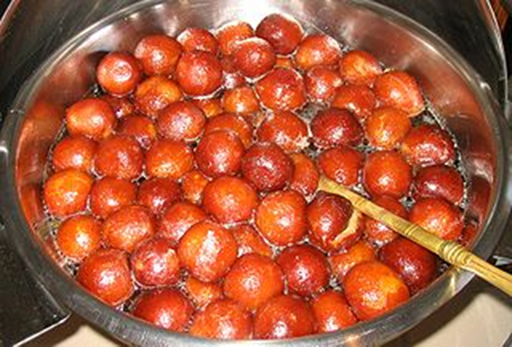4 What happens if …?
Playfulness involves thinking about changes in situations – sometimes referred to as ‘what if …?’ thinking. This works very well with thinking about variables in mathematics: ‘What if I change this variable? What will happen to the other variables then?’ In this process of thinking of possibilities, the role of and proportional connection between variables and constants can also be discovered.
The next activity asks students to think about ‘What happens if I change …?’ They can get a sense of ownership and feeling valued for their thinking powers from coming up with their own conjectures. To increase that ownership further, students are asked to imagine they are doing the mathematics as part of setting up their own sweet shop.
Activity 3: Gulab jamuns and direct and inverse variations
Part 1: Planning to stock your sweet shop
Introduce your class to the following scenario.
Sant Sweets Shop prepares gulab jamuns that are spheres of diameter 1.5 inches. The cost of each gulab jamun is Rs. 12. In each 1 kg box, Sant Sweets can pack 24 gulab jamuns.
- Do you think all sweet shops in India prepare gulab jamuns with the same diameter of 1.5 inches?
- Do you think all sweet shops in India sell gulab jamun for Rs. 12?
Now, imagine you are opening a sweet shop and you are thinking of selling gulab jamuns (Figure 3), but you want to make yours a little bit different from Sant Sweets Shop.
- If you increase the diameter of the gulab jamun, do you expect the price of the gulab jamun to increase or decrease?
- If you increase the diameter of the gulab jamun, will the number of gulab jamuns that can be packed into one box increase or decrease?
- In business it is always important to foresee what will happen when you change something. Based on your responses so far, fill in a copy of Table 1 below. In the table plus (+) denotes increase in value and minus (–) indicates a decrease in value. For each row, you are given one variation. You have to find the other two.

This part of the activity is suitable for developing into a role play. For example, you might want to organise your class into groups, with each group making up a name for their sweet shop and assigning roles to group members. The key resource ‘Storytelling, songs, role play and drama’ will help you if you decide to use this approach.
| Size of gulab jamun | Price of gulab jamun | No. of gulab jamuns in 1 kg box |
|---|---|---|
| + | ||
| + | ||
| + | ||
| – | ||
| – | ||
| – |
Part 2: Exploring direct and inverse variation
- Ask each student, on their own or in pairs, to think of their sweet shop and to write as many pairs of quantities they can think of whose values are related to each other.
- Ask the students to classify each pair of quantities as:
- Direct variation – if one quantity increases, the other does too.
- Inverse variation – if one quantity increases, the other decreases.
- No variation – a change in one of the quantities does not mean a change in the other quantity.
Part 3: Ending the lesson
In Case Study 3 below, Mrs Rawool ends this activity by giving descriptions of direct, indirect and no proportion, as well as some examples. How will you end your lesson and summarise the learning?
Video: Storytelling, songs, role play and drama |
Case Study 3: Mrs Rawool reflects on using Activity 3
I thought this activity would be done better in groups, so that there could be a greater participation of each student. They had a great time discussing the different parts of the activity. I had also asked each group to keep a written note of their discussions. The level of noise was at a maximum, but the talk was mainly using mathematics terminology like: ‘As the price will include the cost of material, then obviously I will increase the price if I increase its radius’; ‘See if the box is of the same size. How can we put more in that box? Obviously the number will decrease’.
After they had filled in the table, I asked the most confident group to write their table on the blackboard and then I asked the others whether they agreed or not; if not, then I asked them to give their opinion on that statement. It worked very well and soon I had a lot of confident students saying why they felt that the quantities varied directly or why they varied inversely. More importantly, they could articulate what they meant by direct or inverse variation. I gave them the next part of the activity as homework so we could have the discussion the next day.
The next day I wrote the descriptions of direct, inverse and no proportional variation on the blackboard and I asked the students to discuss with their classmates the pairs of quantities of objects in ‘their’ shop that they thought related to each other. I asked them to think about: (a) was there a relationship; and (b) what kind of relationship was it: direct, inverse or none at all. In a whole-class discussion I then asked first for examples of quantities that were in direct proportion, then examples of inverse proportion, then examples where there was no proportional relationship. Lots of examples were given and although it did mean the descriptions were repeated over and over again, I am pretty sure they knew the difference by the end of the lesson!
Pause for thought
|
3 The role of playfulness in supporting creativity in mathematics
